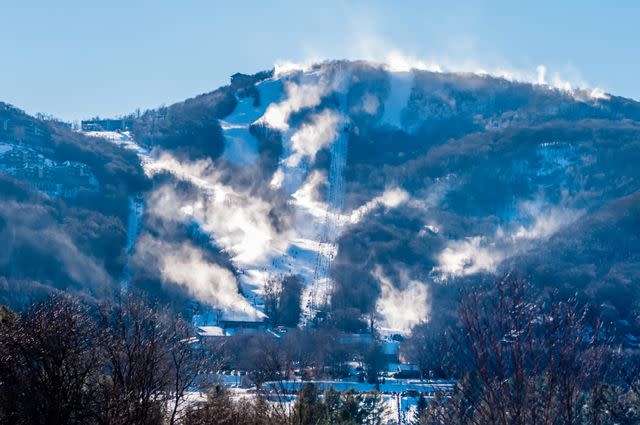Does It Snow In North Carolina?
We're breaking down everything you need to know about North Carolina's climate in advance of the winter months.
No matter what scenery you're seeking, North Carolina has some of the most beautiful spots in the South. But what does the state look like in the winter months? Are those Blue Ridge Mountains blanketed with snow? Will the beach towns on the Outer Banks—a popular destination for holiday vacationers—see any flurries? If you're wondering what the chances are of a white Christmas in North Carolina, look no further. We're breaking down everything you need to know about North Carolina's climate in advance of the winter months and answer the ultimate question: Does it snow in North Carolina?

How Much Does It Snow In North Carolina?
The short answer is that yes, it snows in North Carolina, but the state's vast geographic diversity yields markedly different amounts of snow. From the mountains to the coast, you'll find snowfall levels in North Carolina vary dramatically by region—and it all boils down to altitude.
From the offbeat mountain town of Asheville to the coastal city of Wilmington, North Carolina is home to a range of climates. The scenic Blue Ridge Mountains that lace across the Western half of the state give way to the hilly urban areas of Charlotte and Greensboro. Further east, you'll stumble upon the hip "Triangle" of Durham, Raleigh, and Chapel Hill before reaching the coastline, comprised of 300 miles of barrier-island beaches—including the famed Outer Banks.
North Carolina's mountainous region—comprising the western quarter of the state—receives the most snowfall. The central area of the state, including urban cities like Charlotte and Raleigh, receives moderate snowfall, while coastal areas such as the Outer Banks see minimal snow.
When Does It Snow In North Carolina?
Snow falls in North Carolina from December to March, though the mountainous regions may see snow as early as November. January is the coldest month in the state, with temperatures hovering in the 40s along the coast and often dropping below freezing in the mountain region. This is when the state gets the most snow, with an average accumulation of 4.2 inches of snowfall.
The Mountains Have The Heaviest Snowfall
North Carolina is home to quite a few of our favorite mountain towns, which makes sense when you consider that the state sits on two of the country's most iconic mountain ranges: the Blue Ridge and Great Smoky Mountains. The Blue Ridge Mountains cover most of the western part of the state, with the southwestern quadrant dipping into the Great Smoky Mountains.
The western region of North Carolina receives the most snow, with quaint mountain towns like Boone and Blowing Rock blanketed in consistent snowfall throughout the winter. The highest elevations at Beech Mountain typically receive an average of 84 inches of snow each winter, according to the Beech Mountain Resort, making this the snowiest area in the state. On the northwestern mountain range, Banner Elk sits between two popular ski resorts, making it a wintertime destination for snow bunnies. Here, you'll find adventure no matter the season; the nearby mountains are home to the state's only double black diamond slope.
One anomaly in the area is Asheville. While the town is nestled in the crook of the Blue Ridge Mountains, the temperate weather surprises some visitors, with annual snowfall accumulation never exceeding 11 inches, according to Explore Asheville. Similarly, Bryson City—a small town at the gateway of Great Smoky Mountains National Park—sees less snow than you might expect, with an average of just 2.6 inches of snowfall in January.
Central North Carolina Has Moderate Snowfall
Descending from the high elevation of the mountains, the urban areas of North Carolina see some snow, but not nearly as much as neighboring Blue Ridge towns. The capital city, Raleigh, receives an average of 6 inches of snow in the wintertime, according to Wake County Economic Development.
Charlotte, the most densely populated North Carolina city, experiences an average of 3.5 inches of snow annually—though, according to WCNC, the Queen City didn't get any snow at all during the 2022-23 winter season. This snow drought can be attributed to warmer and drier winters.
Flurries Rarely Hit North Carolina's Coast
If you're dreaming of a white Christmas on North Carolina's Outer Banks, you might just want to put a spoon under your pillow. The state's coastal region does see some snow, though it's relatively rare. Nag's Head averages 1 inch of snow per year, as does the southeastern coastal city of Wilmington.
But not all hope is lost. In 2022, a winter storm swept through the Triangle and along North Carolina's coast, depositing up to 4 to 6 inches in the Northern Outer Banks. The power outages and ice brought with the storm caused headaches for many, according to NPR.
For more Southern Living news, make sure to sign up for our newsletter!
Read the original article on Southern Living.
